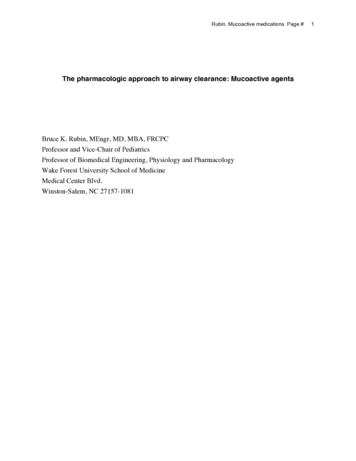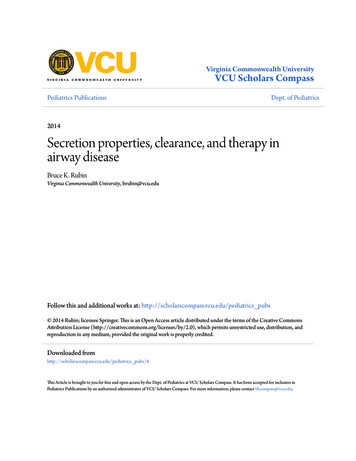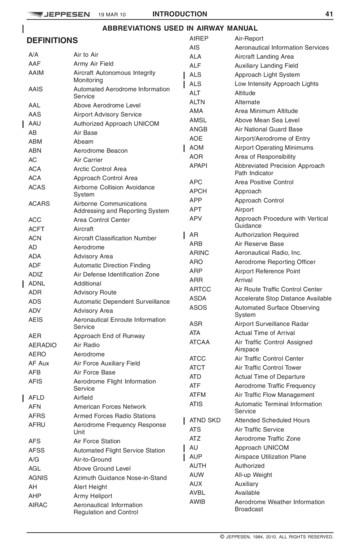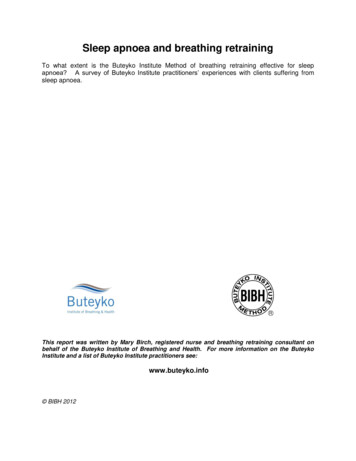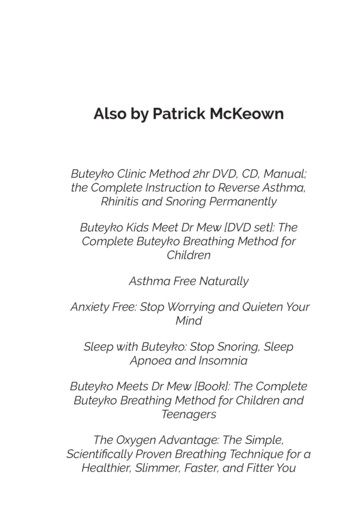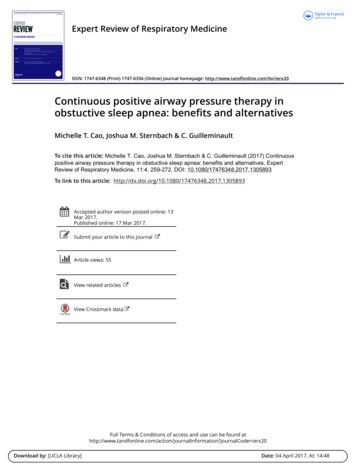
Transcription
Expert Review of Respiratory MedicineISSN: 1747-6348 (Print) 1747-6356 (Online) Journal homepage: http://www.tandfonline.com/loi/ierx20Continuous positive airway pressure therapy inobstuctive sleep apnea: benefits and alternativesMichelle T. Cao, Joshua M. Sternbach & C. GuilleminaultTo cite this article: Michelle T. Cao, Joshua M. Sternbach & C. Guilleminault (2017) Continuouspositive airway pressure therapy in obstuctive sleep apnea: benefits and alternatives, ExpertReview of Respiratory Medicine, 11:4, 259-272, DOI: 10.1080/17476348.2017.1305893To link to this article: epted author version posted online: 13Mar 2017.Published online: 17 Mar 2017.Submit your article to this journalArticle views: 55View related articlesView Crossmark dataFull Terms & Conditions of access and use can be found tion?journalCode ierx20Download by: [UCLA Library]Date: 04 April 2017, At: 14:48
EXPERT REVIEW OF RESPIRATORY MEDICINE, 2017VOL. 11, NO. 4, 305893REVIEWContinuous positive airway pressure therapy in obstuctive sleep apnea: benefitsand alternativesMichelle T. Cao, Joshua M. Sternbach and C. GuilleminaultDivision of Sleep Medicine, Stanford University, Redwood City, CA, USAABSTRACTARTICLE HISTORYIntroduction: Obstructive sleep apnea (OSA) is a highly prevalent condition affecting persons of all agewith an increasing public health burden. It is implicated in cardiovascular disease, metabolic syndrome,neurocognitive impairment, reductions in quality of life, and increased motor vehicle accidents. Thegoals of OSA treatment are to improve sleep and daytime symptoms, and minimize cardiovascular risks.Areas covered: Continuous positive airway pressure (CPAP) is considered the gold standard therapythat delivers pressurized air into the upper airway to relieve obstruction during sleep. Although CPAP isan effective modality of treatment for OSA, adherence to therapy is highly variable. This article highlights the benefits of CPAP therapy, along with alternative treatment options including oral appliance,implantable and wearable devices, and surgery.Expert commentary: CPAP therapy is the gold standard treatment option and should continue to beoffered to those who suffer from OSA. Alternative options are available for those who are unable toadhere to CPAP or choose an alternative treatment modality. The most interesting advances have beenincorporating orthodontic procedures in conjunction with myofunctional therapy in prepubertal children, raising the possibility of OSA prevention by initiating treatment early in life.Received 30 May 2016Accepted 9 March 20171. IntroductionTreatment options for OSA include positive airway pressure(PAP) therapies, sleep apnea surgery, implantable and wearable devices. This is an up-to-date comprehensive review thatdiscusses CPAP therapy and alternatives for the treatmentof OSA.Favorable effects of CPAP therapy in OSA continue to berealized. Since the initial introduction of CPAP by Sullivan in1981, its application to expanding patient populations hasproduced new opportunities for clinical investigation [1]. Theprevious 5 years have also seen growth in alternative treatments, providing an ever-evolving basis for therapeutic comparison. This review’s aim is to summarize the recent stridesmade with respect to clinical success while highlighting thosestudies with comparative and placebo-controlled strategieswhen possible. With regard to CPAP treatment and cardiovascular outcomes, it is important to mention the frequent intersection between OSA and obesity in study participants. Forour purposes, we will direct focus toward the use of CPAP innonobese patients in order to underscore the ramifications oftreating OSA as a disease in isolation.2. Benefits of CPAP2.1. BackgroundThe association of sleep-disordered breathing and symptomsof sleepiness and poor quality of life derives from largeCONTACT Michelle T. CaoCity, CA 94063, USAmichellecao@stanford.edu 2017 Informa UK Limited, trading as Taylor & Francis GroupKEYWORDSSleep apnea; OSA; obesity;CPAP; oral appliance;mandibular advancementdevice; sleep apnea surgery;myofunctional therapypopulation-based inquiries including the Sleep Heart Health[2] and Wisconsin Sleep Cohort studies [3]. Data from theseinvestigations established firm relationships between respiratory disturbance during sleep and daytime sleepiness, even inthose with milder forms of sleep-disordered breathing [4]. Inaddition, these data highlighted the development of depression as well as cardiovascular morbidity and mortality as aresult of sleep disruption [5]. When considering an overview ofclinical benefits related to CPAP, we will focus on recentinvestigations of quality of life (including sleepiness), neurocognition, cardiovascular health and metabolism.2.2. Quality of lifeThe improvements in daytime function and sleepiness attributable to PAP have long been understood. Early randomized,placebo-controlled studies and subsequent systematic reviewsformed the basis for CPAP prescription with the intent oftargeting daytime sleepiness and mood symptoms [6,7]. Adose–response effect has also been found with respect toCPAP treatment and improvement in Epworth SleepinessScale scores [8], and these findings have had important publichealth implications, with meta-analyses showing a reductionin reported road traffic accidents with CPAP treatment.Antonopoulos and colleagues calculated a number neededto treat (NNT) of five – indicating the number of patientsthat would have to receive CPAP treatment to prevent thereport of at least one road accident. The NNT for near missDivision of Sleep Medicine, Stanford University, 450 Broadway Street Pavilion C, 2nd Floor, Redwood
260M. T. CAO ET AL.accidents was only two, and a significant reduction in accident-related events was also seen in tests performed on driving simulators [9]. However, it is important to note thatneurocognitive impairment and daytime sleepiness do notnormalize in a proportion of OSA patients despite adequateCPAP use [8].Recently, studies assessing quality of life have consideredexpanded treatment courses and new patient populations. ABrazilian study found that after 1 year of CPAP use, patientswith moderate severity OSA (apnea hypopnea index [AHI] 20events per hour) and a body mass index (BMI) less than 40 kg/m2 demonstrated a gain in terms of quality adjusted life years(QALY) [10]. Given that the majority of scientific study hasfocused on middle-aged adults, Martinez-Garcia and colleagues undertook to examine the elderly population. In patientsover 70 years old with severe OSA (AHI 30 events per hour),3 months of CPAP use (versus no treatment) improved qualityof life measures, sleep-related symptoms, anxiety and depression as well as blood pressure and neurocognitive testing [11].2.3. NeurocognitionWith regard to neurocognitive symptoms, OSA has beenknown to inflict detrimental effects as judged by tests ofsustained attention, visuospatial learning, executive function,motor performance, and constructional abilities [12], and thishas been confirmed by a recent meta-analysis [13]. Studiesexamining the degree of reversibility of these deficits haveencountered measured success. The APPLES study, a 6month randomized, double blind, sham-controlled trial evaluated attention and psychomotor function (A/P), learningand memory (L/M) and executive and frontal lobe function(E/F). This demonstrated only an improvement in E/F at 2month follow-up, particularly in those with more severe OSA[14]. In a meta-analysis of five studies examining the impactof OSA on executive functioning before and after treatment,all five domains of executive functioning demonstratedimpairments, independent of age and disease severity. Alldomains were noted to have mild to moderate improvements with CPAP treatment [15].In addition to neuropsychological testing, there has beenrecent interest in neuroimaging as a modality for assessing theneurologic detriment of OSA as well as the potential benefit ofCPAP. The notion of evaluating structural changes in the brainassociated with sleep apnea began in the late 1990s with useof magnetic resonance spectroscopy (MRS) [16]. Magneticresonance imaging (MRI) has demonstrated structural changesin brain regions of OSA patients, including areas that regulatememory and executive function [17,18]. Functional MRI (fMRI)has also been explored. Prilipko and colleagues, noting thatprevious studies using transcranial Doppler have shownimpaired cerebrovascular reactivity in OSA patients [19], utilized fMRI to examine the anatomical distribution of reactivitychanges. Flow-sensitive alternating inversion recovery (FAIR)imaging before and after 2 months of therapeutic (active) orsub-therapeutic (sham) CPAP treatment demonstratedincreased reactivity in the thalamus of CPAP patients. By contrast, those using sham CPAP had decreased reactivity [20]. Inanother study of elderly patients ( 65 years old) randomizedto 3 months of CPAP (versus conservative care), those in theCPAP group showed increased connectivity in the frontalgyrus while the control group had a higher percentage ofcortical thinning [21].Investigation into the combined use of neuropsychometric testing and imaging has also been performed.Castronovo and colleagues performed the first study usingfMRI to compare brain activation in OSA versus healthycontrols during a cognitive test of working memory (then-back task). Following 3 months of CPAP treatment inboth groups, no difference was seen in n-back task.However, additional cognitive testing showed improvementin the OSA group where greater activation was seen in theleft frontal cortex, medial precuneus, hippocampus, anddecreased activation in the caudal pons. This was interpreted as a compensatory over-recruitment, as decreasesof activation in prefrontal and hippocampal structureswere observed after treatment [22] (i.e. due to OSA therewas higher neuronal network activity and metabolism compared in controls).Most studies testing the effect of CPAP on cognition havefocused on brain regions that consistently exhibited increasedactivation with tasks requiring attention or executive control[23–25]. The network of those regions has been previouslydescribed as the Task Positive Network (TPN) as it exhibits anincrease in activation when subjects engage in cognitive tasks.TPN comprises several functional networks reported in thecognitive literature such as the frontoparietal attention network, executive network, and right hemisphere-lateralizedventral frontal networks [26,27]. In recent years, however, ithas become clear that a set of brain regions operates antagonistically to the TPN and that optimal coupling between thisset and the TPN is mandatory for successful behavioral performance [28,29]. This network of TPN anti-correlated brainregions is more active during rest and responds with progressive deactivation to external goal-oriented task. It has beendescribed and is commonly referred to as the Default ModeNetwork (DMN) in studies of functional connectivity or TaskNegative Network/Task Deactivation Network (TNN/TDN) instudies of cognitive task performance [29–31].Using fMRI and working-memory task, Prilipko and colleagues [32] performed an investigation examining the effects ofCPAP on TPN and DMN networks of OSAS patients and compared results to those observed in healthy controls and inpatients with sham CPAP. The main finding of the study wasthat active and sham CPAP had opposite effects on behavioralperformance and cerebral activation. The findings of oppositeresponse in deactivation of the temporal brain regions after2 months of active and sham-CPAP treatment supported thehypothesis that OSA has a negative impact on the temporallobe part of the DMN, possibly via the effects of nocturnalhypoxemia.In parallel to the Prilipko et al. study, O’Donghue et al. [33]found metabolic abnormalities in the hippocampus of OSApatients comparable in magnitude to changes found inAlzheimer’s disease. Those changes were no longer detectableafter 6 months of CPAP treatment. Overall, the most consistentfindings in structural neuroimaging studies of OSA patientsare signs of hippocampal injury [17,34–36]. The study by
EXPERT REVIEW OF RESPIRATORY MEDICINEO’Donghue and colleagues suggests that the hippocampus,even if sensitive to OSA-related injury, has the potential forrecovery with CPAP treatment. Prilipko and colleagues indicated that their study involving CPAP, sham CPAP and healthycontrols showed two different aspects of CPAP treatmentwhen considering cerebral task-related activation and deactivation and behavior parameters: elimination of episodes ofnocturnal hypoxemia and decrease in sleep fragmentationwith subsequent improvement of vigilance levels. For theauthors, the ‘improvement of alertness’ effect is supportedby the higher activation shown by healthy controls initiallycompared to OSA patients in the bilateral anterior insular/inferior frontal regions (which constitute the ‘alerting’ nodeof the TPN) [37,38], as well as in the right ventral frontal cortex[27] and by the accentuation of these differences after shamCPAP treatment. However, one must not ignore the impairment of the DMN as mentioned above, particularly the temporal part of the system hypothesized to be related tohypoxemia. This would mean that depending on the importance of sleep fragmentation versus hypoxemia, there wouldbe differences in the impact of OSA and response to CPAPtreatment. Many of the symptoms brought up by OSA patientscan be related to the findings outlined in these studies, andtheir results are important as they indicate that neurocognitivechanges may be reversible with long and regular usage ofCPAP.2.4. Cardiovascular and metabolic effectsBoth fatal and nonfatal cardiovascular events have been notedto occur with greater frequency in untreate
Introduction: Obstructive sleep apnea (OSA) is a highly prevalent condition affecting persons of all age with an increasing public health burden. It is implicated in cardiovascular disease, metabolic syndrome, neurocognitive impairment, reductions in quality of life, and increased motor vehicle accidents.
